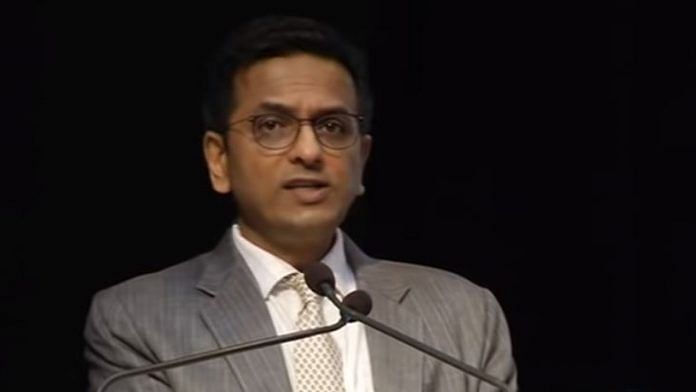New Delhi: An open-court hearing is the “spine” of the justice delivery system, and cannot be substituted by virtual courts, Supreme Court Justice D.Y. Chandrachud said Sunday at a webinar organised by students of the NALSAR University of Law, Hyderabad.
The Supreme Court has been conducting hearings online via video conferencing to adapt to social distancing measures and protect the lives of lawyers and litigants.
“Virtual courts will not displace open courts. They cannot be a substitute or panacea for open courts,” said the judge.
Chandrachud, chairman of the Supreme Court’s e-committee, also said deliberations were on to frame a model for live-streaming of cases involving important questions of law.
Also read: Covid pushes Supreme Court to fast-track reforms, justice delivery could get smoother
‘Digital hearing empowers young lawyers’
Hearings via video-conferencing have so far been seamless, despite a few setbacks, the judge said in response to a question.
“Of course we have had glitches. How could we not have with the sudden pandemic? But there is enormous potential (in use of technology) in future, provided we take it forward involving all stakeholders,” Chandrachud said.
He said technology has been “extraordinarily enabling and empowering for young lawyers”. “It makes no difference who argues, while in open courts, successful advocates are noticed much faster. Everybody enjoys the same platform during virtual hearings,” he said.
Chandrachud hoped that a technology-enabled justice delivery system would attract the younger generation from law schools to look at a career in litigation. “One of the great sources of sadness is that we want more and more law students from the best law schools to come to the lawyering side of the profession. I feel technology will make it more attractive for young lawyers, who would otherwise want to join law firms,” he said.
Asked about high courts using the video-conferencing app Zoom in the backdrop of security concerns, the judge said he has left it to respective courts to choose the platform on which to conduct hearings.
The Supreme Court uses the app VIDYO for its hearings.
‘Technology should be inclusive’
Justice Chandrachud was of the view that judiciary must grab this opportunity for change. He said the Supreme Court’s e-committee was working at developing technology that would make justice delivery more inclusive, not just for litigants but lawyers too.
“I believe that we must have, in due course, a judge of the Supreme Court who will be visually impaired. And certainly, judges in the high court and lawyers should lead lives of dignity. There is no exception to the rules of human dignity that excludes the visually impaired,” he said.
Chandrachud added that work was underway to make the Supreme Court’s e-filing project disabled-friendly. “I am personally working on this and have discussed it with high courts. We would like to see lawyers from all backgrounds use the system in the most efficient manner. For this, a collaborative approach between judiciary and bar associations needs to be undertaken,” he said.
Asked whether courts in the Northeastern states shall benefit from measures which the e-committee has contemplated, the judge said: “We will be able to provide robust infrastructure in terms of hardware and software across the length and breadth of the country, including the Northeastern states.”
Also read: ‘Public hearing fundamental to democracy’: Lawyers on SC hearings via video conference
‘No quick access for the influential’
Asked if people with influence were able to access quick hearings during the lockdown period, Chandrachud said: “It has become a fashion to say that it’s easy for the influential to access. I have data to show that matters of bail being heard in all high courts and trial courts across the country were of cases involving common citizens. Even the Supreme Court has similar data.”
He also explained how listing of cases was done in the top court, saying that only those categorised as ‘urgent hearings’ were taken up first. Eventually, he said, more cases got listed, and now the Supreme Court would proceed towards hearing the regular ones.
On live-streaming of cases, the judge said though the model is being worked upon, the court will have to determine a category to exempt cases involving privacy issues from getting telecast. “In my personal view, cases of child sexual abuse, gender bias, rape, matrimonial disputes and even cases of commercial confidence need to be exempted,” he said.
Justice Chandrachud also spoke on how digitisation of case records and proceedings will not violate one’s right to be forgotten. He said he had dealt with this “philosophical question” in his dissenting opinion on Aadhaar, but the same was not the law of the land.
Even now, he said, judgments were being uploaded on the Supreme Court’s website.
Also read: Collegium recommendations should not be vetoed by the govt: Justice Deepak Gupta






